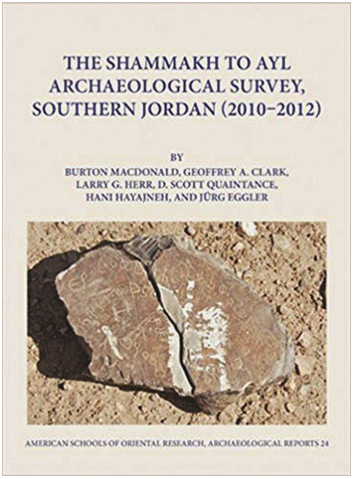
This fieldwork report presents the results of an archaeological survey conducted by Burton MacDonald and his team in the area between Shammakh and Ayl in southern Jordan. The report consists of eight chapters, and nine appendices. The first chapter introduces the project’s objectives, the study area, previous work, the methodology and the type of sites recorded during the fieldwork. Due to the huge area that the survey covered (590km²); three topographic zones (all mountainous and hilly, ranging in elevation from 1200m to more than 1500m asl) were chosen for investigation. One hundred and fifteen squares, 500×500m each, were randomly selected for thorough inspection. Twelve squares were located in zone 1, 26 squares in zone 2, and 70 squares in zone 3. Each square was systematically traversed by the survey team and any evidence of past human activities was recorded as a site. By the end of the two-year project, 366 archaeological sites had been recorded. A list of all sites, their coordinates, their names (if known) and their possible functions is included in a table at the end of Chapter 1.
Chapter 2 of the report is a description of a number of squares, randomly chosen from the three zones for this purpose. Besides the description of the selected squares, in terms of their geographic and topographic locations and characteristics, there is information about the archaeological periods represented at each square. There are also drawings of the finds, lithics and pottery, and tables of the analysed ceramic sherds (type, fabric colour, surface treatment and decoration). Chapter 3 is the core of the monograph, consisting of 335 pages of site descriptions. It is more or less a site ‘gazetteer’ with information about each site’s name, coordinates, periods represented, general description, finds drawings, and tables presenting analysis of materials collected. Chapter 4 presents and discusses the archaeological evidence of the Palaeolithic period, in this region dated from approximately 1.5 million to 40000 years ago. Material culture of this age comes from the three zones, and Geoffery Clark uses statistical methods to determine the distribution of lithics across time and space. The author uses the data from the study area to introduce new approaches to understand and analyse better the archaeological evidence of this age. He concludes that the Middle Palaeolithic (250000–40000 years ago), unlike the lower and upper periods, is well attested in the study area.
Chapter 5 is a summary of the settlement patterns and site distributions across the study area, based solely on the analysis of surface ceramics. It starts with a brief discussion of the Holocene climate based on studies of the southern Levant. The author, Burton MacDonald, then discusses the different factors that clearly impact settlement patterns, particularly natural resources such as water, soil and minerals. The climate and distribution of natural resources both affected the distribution of settlements throughout the prehistoric and historical periods in the study area. The climatic studies indicate cyclical wet and dry periods, and the archaeological evidence shows that these correspond to changes in the density of human occupation. The ceramic evidence reveals that the area witnessed substantial human occupation during the following periods: Chalcolithic–Early Bronze (4900–2000 BC), Iron II (1000–539 BC), Nabataean (63 BC–AD 324), Roman (63 BC–AD 324), Byzantine (AD 324–640) and Late Islamic (AD 1517–1917). Sites with agricultural function such as villages, hamlets and farms, as well as watchtowers and forts, are the most common types of sites in the abovementioned periods. The illustrations in this chapter, mainly maps, and the tables are informative and can be easily read and understood.
Chapter 6 presents a different set of data that includes ancient north Arabian inscriptions, tribal brands (wasms) and rock art drawings. The north Arabian inscriptions use the characters of an ancient writing system that is found within northern Arabia and the arid lands of the Levant. The date of these inscriptions is uncertain as they generally lack a written date formula, and this issue is still being debated among epigraphists. Five ancient north Arabian inscriptions are published in the monograph besides tens of tribal brands. The latter are certain symbols of circles, angles, lines and other shapes. Each symbol is thought to refer to a certain tribe, pointing to its existence or control in the area where these symbols are found. The same symbols were used to mark the bodies of domestic animals to indicate their ownership by the Bedouin tribes. Tens of rock art drawings, ancient and modern, were also recorded in the study area. They resemble, in subject and location, the rock drawings from other parts of Jordan, the Levant and Arabia. Overwhelmingly, they show animals, humans and unidentified figures.
Chapter 7 consists of one page explaining the details of a seal impression on a jar rim. The seal is dated to the Early Iron Age (twelfth to eleventh centuries BC) on the basis of stylistic characteristics of the depicted figure. Finally, the five pages of Chapter 8 summarise the previous chapters and present the outcomes of the overall project. In brief, this work is comprehensive, informative and adds to our knowledge through new data. More importantly, by bringing some of the abundance of archaeological remains in this region to publication, the volume should motivate new research questions and further fieldwork.


